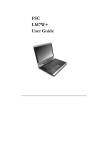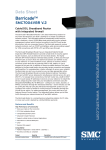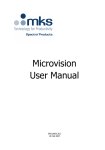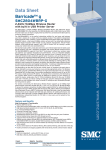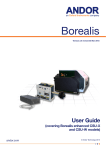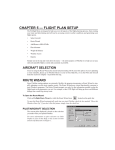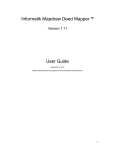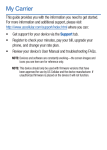Download Magellan GPS 310
Transcript
GPS 310 Satellite Navigator User Manual WARNINGS A measure of knowledge by the user is required for proper and safe use of the Magellan GPS 310™. READ THE USER MANUAL & WARRANTY COMPLETELY. Use Good Judgment This product is an excellent navigation aid, but it does not replace the need for careful orientation and good judgment. Never rely solely on one device for navigating. Use Care to Avoid Inaccuracies The Global Positioning System (GPS) is operated by the U.S. Government, which is solely responsible for the accuracy and the maintenance of GPS. Certain conditions can make the system less accurate. No part of this Manual may be reproduced or transmitted in any form or by any means, electronic or mechanical, including photocopying and recording, for any purpose other than the purchaser’s personal use, without the written permission of Magellan Corporation. © Copyright 2000 by Magellan Corporation. All rights reserved. Magellan™ and GPS 310™ are the trademarks of Magellan Corporation. P/N 630786 B TABLE OF CONTENTS Introduction .................................................... 1 Welcome to the Magellan GPS 310 ..................................... 1 GPS 310 Description ........................................................... 1 Magellan GPS 310 Key Functions ....................................... 2 Getting Started ................................................ 3 Installing the Batteries ......................................................... 3 Getting Signals from Satellites ............................................. 3 Initializing the Receiver - EZStart ........................................ 4 Computing a Position .......................................................... 5 Basic Operation ............................................... 7 Saving a Position Fix ............................................................ 7 Creating a Landmark ........................................................... 8 Viewing the POSITION Screen ........................................... 9 Viewing the NAVIGATION Screens .................................. 10 Creating a GOTO Route ................................................... 13 Summary ........................................................................... 14 Working with Landmarks .............................. 15 Viewing a Landmark .......................................................... 15 Editing a Landmark ........................................................... 16 Deleting a Landmark ......................................................... 16 i GPS 310 TOC 1 10/18/99, 9:27 AM Working with Routes..................................... 17 Creating a Route ................................................................ 17 Viewing a Route ................................................................ 19 Activating/Deactivating a Route ........................................ 20 Deleting a Route ................................................................ 21 Adding Legs to a Route ...................................................... 21 Activating a Leg in a Route ................................................ 22 Editing a Leg in a Route .................................................... 23 Deleting a Leg From a Route ............................................. 24 Reversing a Route .............................................................. 24 Additional Features ....................................... 25 Viewing the Time and Date ............................................... 25 Viewing Elevation .............................................................. 25 Viewing Battery Life .......................................................... 25 Changing Coordinate Systems ........................................... 26 Changing Map Datums ..................................................... 27 Changing Distance Units ................................................... 28 Changing Time Display and Time ..................................... 28 Changing North Reference ................................................ 29 Initializing the Receiver (EZSTART) ................................. 29 Activating the Demo Mode ................................................ 30 Setting Display Contrast .................................................... 31 Using the Trip Odometer ................................................... 31 Connecting to External Devices .................... 32 NMEA Data Messages ................................... 34 Troubleshooting ............................................ 41 Frequently Asked Questions .............................................. 42 Icons .................................................................................. 44 Contacting Magellan ......................................................... 45 ii GPS 310 TOC 2 10/18/99, 9:27 AM Accessories ..................................................... 46 Attaching the Wrist Lanyard .......................... 47 Shipping/Transporting .................................. 48 Glossary ......................................................... 49 Index ............................................................. 52 iii GPS 310 TOC 3 10/18/99, 9:27 AM iv GPS 310 TOC 4 10/18/99, 9:27 AM Introduction Welcome to the Magellan GPS 310 Congratulations on your purchase of the Magellan GPS 310 satellite navigator. The GPS 310 is an easy-to-use GPS receiver designed to get you out in the “Great Outdoors” rather than spending hours reading a User’s Manual. There are, however, a few items that you need to be familiar with so it is suggested that you follow along at least through the chapter on Basic Operation. Before you begin, make sure that your package includes the items listed on the GPS 310 box. If any items are missing or damaged, contact your Magellan dealer or retailer. GPS 310 Description The GPS 310 is a self-contained hand-held GPS receiver designed for general purpose position locating and navigation. It has a built-in antenna located at the top of the receiver, a backlit display, and keypad. Using two AA batteries, inserted from the battery door found at the back of the receiver, the GPS 310 will operate for up to 20 hours. 1 Magellan GPS 310 Key Functions GPS Antenna G P S 310 The ENTER key confirms data entries or menu selections. The NAV key accesses the Position and Navigation screens. The GOTO key is used to create a direct route to any landmark stored in memory. ENTER NAV MARK The MARK key is used to create landmarks and store the current position. The LIGHT key turns the light on and off. 2 GOTO MENU The MENU key is used to access the route, landmark and setup functions. PWR The PWR key turns the receiver on and off. The ARROW pad is used to enter landmark names, and scroll through the series of screens and menu selections. Getting Started Installing the Batteries The GPS 310 uses two AA alkaline batteries that are installed at the back of the receiver. To remove the battery cover, turn the ring of the battery door screw counterclockwise until the battery cover can be removed. Insert the new batteries as shown, being sure to respect the polarities, and replace the battery cover. + + - Replace the screw and turn the ring clockwise until the battery door is held in place securely. While the battery door does provide the waterproofing seal to the batteries, you should avoid overtightening the battery door screw. Getting Signals from Satellites Since the GPS 310 receives information from satellites orbiting the earth, the antenna needs to have a relatively unobstructed view of the sky. Large obstructions such as buildings, cliffs, and overhangs may interfere with signal reception causing your GPS 310 to take additional time to compute your location. 3 The GPS 310 is designed to fit comfortably in your hand. Hold the receiver with the antenna towards the sky. Initializing the Receiver - EZStart Before using your GPS 310 for the first time, the receiver needs to know its approximate location. Using Magellan’s EZStart procedure, the GPS 310 will prompt you for the information it requires when you turn it on for the first time. You do not need to initialize your receiver each time you use it. Follow these steps to initialize the GPS 310 if this is the first time you are using it. � Press PWR to turn the GPS 310 on. � SELECT REGION. Use the ARROW pad to change the flashing text to select the appropriate region for your present location. Press ENTER � SELECT COUNTRY or STATE. Use the ARROW pad to change the flashing text to select the country or state for your present location. Press 4 ENTER � ENTER ELEVATION. Use the ARROW pad to enter the approximate elevation for your position. If unknown, leave the elevation at 0. Press ENTER � ENTER TIME. Use the ARROW pad to enter your present time. Press ENTER � ENTER DATE. Use the ARROW pad to enter the date. Press ENTER The GPS 310 then displays the POSITION screen and automatically begins searching for satellites that it knows are in this area for the date and time you entered. The display shown here may differ from yours depending upon the information you selected in steps 2 and 3. As the GPS 310 scans the sky, the arrow in the circle will swing around pointing to a satellite and displays, in the center of the circle, that satellite’s elevation above the horizon. Computing a Position The GPS 310 will begin to acquire information from the satellites and use this information to compute your current position (called a position fix). Whether you have just 5 completed the initialization process or have just turned your GPS 310 on, the GPS 310 will display the following screens in the order shown. As the GPS 310 searches for satellites, some of the small circles around the large circle will become black indicating that the GPS 310 is tracking that satellite and receiving information. The number at the bottom right of the screen displays how many satellites are being tracked. After the GPS receiver has received positioning data from at least three satellites (approximately 2-3 minutes), it will begin computing a position fix based upon the information it is receiving. As soon as a position fix is computed, the receiver switches to the navigation screen displaying the moving compass. The word “TRACKING” is displayed in the lower right corner indicating that the receiver is computing position fixes. Note: If the receiver has not acquired a position fix in approximately 10 minutes, refer to the troubleshooting section of this manual. More information on these screens and the information they display can be found in the next chapter. 6 Basic Operation Saving a Position Fix Position fixes can be saved in memory for use later when you want to return to that position. Saved position fixes are referred to as landmarks or LMK. To save (mark) your current position press MARK . Receiver-Generated Name: The GPS 310 prompts you to enter a name or accept the receiver-generated name for this landmark. To accept the receiver-generated name (LM01 - LM99), press ENTER To quickly save a position fix, press MARK MARK . User-Created Name: To create a name (up to four characters), use the UP/DOWN arrows to change the character and the LEFT/RIGHT arrows to move the cursor to the left or right respectively. After you have input the desired landmark name press Press ENTER ENTER ENTER . to accept the current latitude and press again to accept the current longitude. Shortcut: Press MARK at anytime while viewing this screen to quickly save the position. 7 Creating a Landmark To create a landmark at a location which is not your current position, use the same procedure as saving a position with the additional step of inputting different latitude/longitude coordinates. To create a landmark press MARK . The GPS 310 prompts you to enter a name or accept the receivergenerated name for this landmark. When the desired name is displayed at the top of the screen press ENTER . Use the ARROW pad to change the latitude and press ENTER to accept. Use the ARROW pad to change the longitude and press ENTER to accept. The newly created landmark is stored in memory and you are returned to the screen that was displayed when you pressed the MARK key. Shortcut: Press MARK at anytime while viewing this screen to quickly save the position. 8 Viewing the POSITION Screen The POSITION screen displays the coordinates for your last computed position and information about any satellites that are visible. It can be accessed by pressing the Latitude and Longitude Satellite Elevation Degrees above the horizon of the satellite indicated by the satellite pointer. NAV key. North Indicator Satellite Pointer Number of satellites being used. Satellite Icons Visible but not tracked. Satellite is being tracked. Tracking Indicator Appears when the receiver has acquired enough information from the satellites to compute a position fix. You may sometimes notice that the number of satellites being tracked differs from the number of satellites being displayed graphically. This is due to more than one satellite being tracked in the same general area. 9 Viewing the Navigation Screens Without an Active Route. Without an active route the navigation screen displays your heading and the speed at which you are traveling. The lower portion of the screen displays a moving compass. The triangle at the top of the compass points in the direction you are traveling and the arrow points to north. Navigation Screen without an Active Route (Moving Compass) Current Heading Current Speed Direction of Travel North Indicator Tracking Indicator Appears when enough satellites have provided information to compute position fixes. The navigation screens display your speed of travel. In order for the North Indicator to be valid and the speed to be displayed, you must be moving at a speed greater than 2 miles per hour. 10 With an Active Route. When you have an active route the navigation screen still displays your heading and speed but also includes the bearing and distance to your destination. The moving compass is then replaced with steering information. You can use the graphical representation or the steering indicator to assist in directing you towards your final destination. Navigation Screen with an Active Route (Steering) Destination Landmark Bearing to Destination Current Heading Destination Icon Distance to Destination Current Speed North Indicator Steering Indicator Indicates the number of degrees to turn, right or left, to destination landmark. Destination Pointer Tracking Indicator Appears when enough satellites have provided information to compute position fixes. In the screen above you are traveling with a heading of 56° while your destination bearing is 34°. This would indicate that you need to turn left 22° to be on a straight line to your destination. The circle and arrow display the same information but in a visual manner. The triangle points in the direction you are traveling and the arrow points towards your destination. 11 A second navigational screen is also provided while you have an active route. This screen is very similar to the first screen except that the distance to the destination has been replaced with XTE (cross track error, the distance left or right that you are off course) and heading has been replaced with TTG (time to go). This screen provides you additional information to aid you in navigating to your destination. Second Navigation Screen with an Active Route (Steering) Destination Landmark Cross Track Error Distance left or right of the desired Courseline. Bearing to Destination Current Speed Time to Go Time remaining to arrive at the destination at your present speed and heading North Indicator Destination Icon Destination Pointer Steering Indicator Indicates the number of degrees to turn, right or left, to destination landmark. Tracking Indicator Appears when enough satellites have provided information to compute position fixes. The navigation screens and the position screen are connected to one another in a circular loop. Pressing the NAV key or using the ARROW pad while viewing one of the position or navigation screens moves you to the next screen in the loop. 12 Creating a GOTO Route The simplest form of a route is a one-leg route called a GOTO route (you are GOing TO a destination). This is routing you from your current position to a landmark stored in memory All that is required to create a GOTO route is that you have saved a landmark indicating the location of your destination. To create (activate) a GOTO Route: From any screen, press GOTO screen appears. GOTO . The To select a different landmark, use the LEFT/RIGHT ARROWS until the desired destination landmark is displayed. Press ENTER or GOTO . The display returns to the Navigation screen showing the name of the GOTO destination at the top of the screen. 13 If the receiver is not tracking sufficient satellites to compute a position fix, the start of the newly created GOTO route will be the last position computed, which may not be the current position. This GOTO route will remain the active route until a new GOTO route is created, a multileg route is activated, or the receiver is turned off. Turning off the receiver deactivates any GOTO route. Summary This completes the basic operation of the GPS 310. At this time it would be a good idea to put what you know to practice. Pick a location that you would want to come back to, your home for example. Take a position fix of the location and save it to memory, giving it a name that you will later associate with this location. Then travel a few miles away with your receiver, stop and take another position fix. Now use the GOTO key to set a GOTO route and highlight the landmark you created before and press ENTER . Your GPS 310 is ready to navigate you back to where you started. The navigation screens are now showing you the distance and bearing back to the original landmark. As you begin moving, the GPS 310 will begin using your speed and direction to compute the shortest distance back to your original starting point as well as how long it will take you to get there. The following chapters provide you with more information on using your GPS 310 that build upon what you’ve learned. 14 Working with Landmarks Viewing a Landmark To view a stored landmark press MENU until LMKS appears at the top of the screen. Press ENTER . The BEARING/DIS- TANCE screen for the first landmark in the receiver’s memory is displayed with the bearing and distance from the last computed position fix to that landmark. To select a different landmark, use the LEFT/RIGHT arrows until the name of the landmark you wish to view is at the top of the screen. To view the POSITION screen of the selected landmark, press the UP ARROW. 15 Editing a Landmark Following the instructions under Viewing a Landmark, use the LEFT/RIGHT arrows to select the landmark you wish to edit. Press the UP ARROW until the screen displays PRESS ENT TO EDIT, then press ENTER . You can modify the landmark name and/or the coordinates for the landmark by using the UP/DOWN arrows to change the information and press ENTER to move to the next line. If the landmark you are editing is used in a route, the route will be modified to reflect the changes you made to the landmark. Deleting a Landmark Following the instructions under Viewing a Landmark, use the LEFT/RIGHT arrows to select the landmark you wish to delete. Press the UP ARROW until the screen displays PRESS ENT TO DELETE, then press ENTER . Use the LEFT/RIGHT ARROWs to confirm (YES or NO) and press ENTER . If the landmark is used in a route or is the destination landmark in a GOTO route, the GPS 310 alerts you that the landmark cannot be deleted. Remove the landmark from the route and repeat. 16 Working with Routes The route function allows you to link a series of landmarks and travel, point by point, to a final destination. D Leg 1 g C Leg 2 Le A 3 B The route depicted here is a three-leg route. Leg 1 extends from landmark A to landmark B, leg 2 from landmark B to landmark C, and leg 3 from C to D. The GPS 310 gives you information on the NAV screens that directs you to the destination of each leg sequentially. Creating a Route A route can contain up to 10 legs using any of the landmarks stored in memory. If there is a route already in memory you must delete the existing route before you can create a new one. Access the Route Menu by pressing MENU until ROUTE appears at the top of the screen. The display should say “PRESS ENT TO CREATE.” NOTE: If the display says PRESS ENT TO VIEW there is an existing route and you must delete the existing route before creating a new one. (See Deleting a Route for details.) Press ENTER . 17 The receiver prompts you for a starting landmark for the route. The first landmark, *POS, is your present position. Use the ARROW pad to scroll through the list of landmarks. When the desired landmark is displayed (and flashing) press ENTER . The display changes to allow the selection of the landmark to be used as the end of the first leg in the route. Use the ARROW pad to scroll through the list of landmarks. When the desired landmark is displayed (and flashing) press ENTER . Note that as you scroll through the list of landmarks, the display updates showing you the bearing and distance from the start of this leg to the displayed landmark. If the distance from the start of the leg to the end of the leg is below 0.10 miles, the message INVALID is displayed and you are prompted to select a different landmark. The screen changes to the next leg in the route with the destination landmark of the previous leg inserted as the start of the next leg. The message END ROUTE is displayed in the TO field. You may continue this route by using the ARROW 18 pad to select a landmark as the destination for this leg or press ENTER to signal the GPS 310 that this was the last leg in the route and you are finished creating a route. Continue this process for each leg in the route remembering to press ENTER with END ROUTE displayed in the TO field to finish up the route. If you accidently pressed the ARROW pad but you meant to end the route, you can still end the route by continuing to press the ARROW pad until END ROUTE is displayed again. A route may contain no more than ten legs and the GPS 310 automatically saves the route and returns to the Route Menu as soon as Leg 10 is entered. After the route has been created, the GPS 310 automatically activates the route and begins providing navigation information for the route. Viewing a Route You can view a summary of the route in memory as well as viewing the individual legs of the route. All editing commands are accessed from the View Route function as well. With a route in memory, press MENU until ROUTE appears at the top of the display. Press ENTER . 19 The first screen displayed is the ROUTE SUMMARY screen. This screen displays the start and end landmark for the entire route as well as the total distance of the route. Use the LEFT/RIGHT ARROWs to view the legs in the route. The leg screen displays the FROM and TO landmark for the leg as well as the distance and bearing for the leg. The circle graphically displays the bearing for the leg. Continue pressing the LEFT/RIGHT ARROWs to step through the other legs in the route, eventually returning to the ROUTE SUMMARY screen. Activating/Deactivating a Route With a route in memory, press MENU until ROUTE appears at the top of the display. Press ENTER . Press the UP ARROW. If the route is currently active, the display indicates: ENT TO DEACTVATE. If the route is currently deactivated, the display indicates: ENT TO ACTIVATE. Pressing ENTER will activate or deactivate the route depending upon its present status. After a route is deactivated, the route summary is displayed. If a route is activated, the NAV screen is displayed. 20 Deleting a Route With a route in memory, press MENU until ROUTE appears at the top of the display. Press ENTER . While still viewing the Route Summary screen, press the UP ARROW three times until the display indicates PRESS ENT TO DELETE. Press ENTER . You will be prompted to confirm the deletion. Use the ARROWs to select YES or NO and press ENTER . Adding Legs to a Route With a route in memory, press MENU until ROUTE appears at the top of the display. Press ENTER . While still viewing the Route Summary screen, press the UP ARROW until the display indicates PRESS ENT TO ADDLEG. Press ENTER . The display changes to the Add Leg screen with END ROUTE flashing. As in creating a route, use the ARROW pad to select the new landmark for this leg. With the new TO landmark flashing, press ENTER . The newly created leg is added to the route. The process of adding a leg continues until you select END ROUTE or the route is full. 21 Activating a Leg in a Route As you are navigating you may decide that you no longer wish to continue on the leg that you are now using. Instead you wish to use another leg of the route. You will need to activate the leg of the route with the desired destination (TO landmark). Press MENU until ROUTE appears at the top of the display. Press ENTER . Use the LEFT/RIGHT ARROWs until the leg you wish to activate is displayed. Press the UP ARROW. If the leg is not active, the display indicates ENT TO ACTIVATE. Press ENTER . The leg has become activated, the NAV screen is displayed, and the receiver begins to compute the necessary information to continue you on the route using the leg you selected. If the display indicates ENT TO DEACTVATE, it means that the receiver is using this leg to compute the navigational information. Pressing ENTER at this screen not only deactivates the leg and returns to the leg summary screen, but deactivates the route as well. 22 Editing a Leg in a Route Press MENU until ROUTE appears at the top of the display. Press ENTER . Use the LEFT/RIGHT ARROWs until the leg you wish to edit is displayed. Press the UP ARROW until PRESS ENT TO EDIT is displayed and press ENTER . The Edit Leg screen is displayed with the FROM landmark flashing. Use the LEFT/RIGHT ARROWs to select a new FROM landmark and press ENTER . The TO landmark begins flashing alerting you that the GPS 310 is ready for you to select a new TO landmark. Press ENTER to accept the TO landmark as it is or use the LEFT/RIGHT ARROWs to select a new TO landmark and press ENTER . The leg before and after the one you just edited will be automatically changed to reflect the changes that were made to this leg. 23 Deleting a Leg From a Route Press MENU until ROUTE appears at the top of the display. Press ENTER . Use the LEFT/RIGHT ARROWs to find the leg of the route that you want to delete. Press the UP ARROW until PRESS ENT TO DELETE is displayed and press ENTER . The GPS 310 prompts you to confirm the deletion of the leg. Use the LEFT/RIGHT ARROW to select (flashing) YES to delete or NO to cancel. If you attempt to delete a leg that causes the route to contain a leg that is under the 0.1 mile leg distance limitation, the receiver will display the message INVALID DELETE. Reversing a Route Press MENU until ROUTE appears at the top of the display. Press ENTER . Press the DOWN ARROW until PRESS ENT TO REVERSE is displayed and press ENTER . The GPS 310 prompts you to confirm the action. Use the LEFT/RIGHT ARROW to select (flashing) YES to reverse or NO to cancel and press 24 ENTER . Additional Features Viewing the Time and Date You can view the current time and date (obtained from the satellites) by repeatedly pressing the is displayed at the top of the screen. MENU key until TIME Viewing Elevation You can view the last computed elevation for your GPS 310 by repeatedly pressing the MENU key until ELEVATION is displayed at the top of the screen. Viewing Battery Life You can view the estimated battery life remaining by repeatedly pressing the MENU key until POWER is displayed at the top of the screen. Full Battery Life 40-60% Battery Life Low Batteries 25 Changing Coordinate Systems You may wish to change the coordinate system that your GPS 310 uses to display the position and landmarks coordinates. You have the following options: LAT/LON using degree/ minutes (DEGMIN), LAT/LON using degree/minutes/ seconds (DEGMINSEC),Universal Transverse Mercator (UTM), OSGB, Irish, Swiss, Swedish, Finnish, French, or German. The choice you make will depend upon the maps or charts you may be using. You want your GPS 310 to be displaying the coordinates in the same mode that your map or chart uses. The following example shows the same position in three different modes. LAT/LON (DEGMIN) Press the MENU LAT/LON (DEGMINSEC) UTM key until SETUP is displayed at the top of the screen and press ENTER . Press ENTER again and the currently used coordinate system begins to flash. Use the RIGHT/LEFT ARROWs to scroll through the list of coordinate systems and press ENTER when the desired system is displayed. Some coordinate systems require additional zone or format information. Use the arrow pad and select the proper zone or format. 26 ENTER to Changing Map Datums If you are using a map (or chart) in conjunction with your GPS 310 you need to insure that the datum used by the GPS 310 matches the one used in creating the map. The map datum can usually be found in the legend box of the map or chart. The GPS 310 offers the choices of WGS84 (default), NAD27, AUST 84, EUROPE 50, GRB 36, IRELAND, KKJ, RT90, S AMERICA 69, SWISS, FRENCH, GERMAN, and TOKYO. Press the MENU key until SETUP is displayed at the top of the screen and press ENTER . Use the RIGHT ARROW until SETUP MAP DATUM is displayed. Press ENTER again, the currently used map datum begins to flash. Use the RIGHT/ LEFT ARROWs to scroll through the list of map datums and press ENTER when the desired datum is displayed. Some coordinate systems can be used only with a specific datum (i.e., OSGB coordinate system can be used only with the GRB 36 datum). Your GPS 310 automatically selects the proper datum when you select that coordinate system and will not allow you to change the datum until you select a different coordinate system. 27 Changing Distance Units Your distance units can be in miles and miles per hour (MIMPH), nautical miles and knots (NM-KTS), or kilometers and kilometers per hour (KM-KPH). To change the units, press MENU and press until SETUP is displayed at the top of the screen ENTER . Use the RIGHT ARROW until SETUP UNITS is displayed. Press ENTER again and, the distance unit of measure begins to flash. Use the RIGHT/LEFT ARROWs to scroll through the list of units and press ENTER when the desired unit of measure is displayed. Changing Time Display and Time To change the way that time is displayed (12 HOUR- default, 24 HOUR, or UT), repeatedly press MENU displayed at the top of the screen and press until SETUP is ENTER . Use the RIGHT ARROW until SETUP TIME is displayed. Press ENTER again and the time display begins to flash. Use the RIGHT/LEFT ARROWs to scroll through the list and press ENTER to select. The screen changes to TIME SET. Use the ARROW pad to set the time and press ENTER when done. (You are not prompted to set the time if you selected UT as the time format.) When you change your clocks because of daylight savings time, remember to change the time in your GPS 310. 28 Changing North Reference The GPS 310 uses magnetic north as a default reference for all navigation computations. You can change this to true north (good if you are also using a map) or back to magnetic north (default, good to use if you are using a compass) under the SETUP menu. Press the MENU key until SETUP is dis- played at the top of the screen and press ENTER . Use the RIGHT ARROW until SETUP NORTH REF is displayed. Press ENTER again, the north reference begins to flash. Use the RIGHT/LEFT ARROWs to scroll between MAGNETIC and TRUE and press ENTER to select. Initializing the Receiver (EZSTART) If you desire to re-initialize the receiver, (for example, you have moved more than 300 miles since the last time the receiver was turned on) you can do so in the SETUP menu. Press MENU and press until SETUP is displayed at the top of the screen ENTER . Use the RIGHT ARROW until SETUP PRESS ENT TO EZSTRT is displayed. Press ENTER again and the receiver prompts you to enter the necessary data. SELECT REGION. Use the ARROW pad to change the flashing text to select the appropriate region for your present location. Press ENTER . 29 SELECT COUNTRY or STATE. Use the ARROW pad to change the flashing text to select the country or state for your present location. Press ENTER . ENTER ELEVATION. Use the ARROW pad to enter the approximate elevation for your position. If unknown, leave the elevation at 0. Press ENTER . ENTER TIME. Use the ARROW pad to enter your present time. Press ENTER . ENTER DATE. Use the ARROW pad to enter the date. Press ENTER . Note: The prompts to enter time and date will not appear if your receiver has already collected this information from the satellites. Activating the Demo Mode To turn on the Demo Mode, press until SETUP is MENU displayed at the top of the screen and press ENTER . Use the RIGHT ARROW until SETUP DEMO is displayed. To toggle between ON or OFF, press ENTER . The present status, on or off, will flash. Use the LEFT/RIGHT ARROWs to switch between on and off and press ENTER . While in the Demo Mode, the receiver displays sample information on the POSITION and both NAVIGATION screens. 30 Setting Display Contrast To adjust the contrast of the display, press MENU until SETUP is displayed at the top of the screen and press ENTER . Use the LEFT/RIGHT ARROW until SETUP CONTRAST is displayed and press ENTER . Use the LEFT/RIGHT AR- ROW keys to change the contrast to the desired level and press ENTER . Using the Trip Odometer Press MENU until the ODOMETER is displayed. The odometer will keep track of the distance you have traveled while using your GPS 310. To reset the odometer press ENTER . You will be asked to confirm that you really want to reset the odometer to zero. Use the LEFT/RIGHT ARROWs to highlight (blinking) YES and press ENTER . 31 Connecting to External Devices The GPS 310 is designed to interface to a PC or other devices using a data cable. The GPS 310 continuously outputs NMEA messages through the data port at a rate of every 1 second. The GSV message is output all the time including when the receiver is not computing fixes. After the first fix is computed, GSA, GLL, GGA and RMC messages are also output. These messages contain position, time, date, satellite position as well as other status information. These messages can be used by a variety of navigation software packages available for the personal computer. If the receiver is computing fixes and has a route set (either a GOTO or a multi-leg route) the RMB and APB messages are also output. The RMB and APB contain information (steering, distance to destination, etc.) used to navigate to the route destination. These messages are used by autopilots and marine navigation software. Connecting the GPS 310 to a Personal Computer (PC) Connect one end of the data cable to the back of the GPS 310 and connect the other end of the data cable (the end with the DB9 connector) to the serial port on the personal computer. Now any application that you run on your PC that accepts NMEA messages will be able to receive that information from your GPS 310. NOTE: Be sure that your PC software is set to the COM port that you connected your data cable to and that the baud rate is set to 4800 baud. 32 Connecting the GPS 310 to an Autopilot Device To connect the GPS 310 to an autopilot or other external device you may need to cut off the DB9 connector and “hard wire” the cable to the device. The cable configuration is as follows: Orange: Data Out Yellow: Data In Black: Ground Red: Power (DO NOT USE) Refer to the manual on the external device and connect the wires to their proper place. Be careful and double check your connections before applying power to the external device as an improper connection could damage the GPS 310 and void its warranty. Connecting the GPS 310 to a DGPS Receiver The GPS 310 is capable of receiving differential corrections from a differential receiver for improved accuracy. By connecting a differential beacon receiver (DBR), such as the Magellan DBR IV, to the GPS 310, corrections are automatically applied to the position and velocity computed by the receiver. If corrections are being applied to the GPS 310, “DGPS” will appear on the top of the position screen. The GPS 310 accepts standard RTCM v2.1 messages at 4800 baud rate. You can use either the Data Cable, Power/Data Cable or PC Cable with Cigarette Lighter to connect the GPS 310 to the DBR. 33 NMEA Data Messages NMEA DATA MESSAGES. NMEA data is output at 4800 baud, 8, N, 1, checksum off. These settings are acceptable to most equipment and software applications. Your GPS receiver outputs the following NMEA 0183 version 2.1 messages. GSA, GSV, GLL, GGA, RMB, RMC and APB. Vers. 2.1 NMEA is recommended for navigation data, satellite data and autopilots. NMEA Message Definitions 34 APB Revised autopilot message contains all of the above plus: heading to steer toward destination, bearing from the present position to the destination (magnetic or true). GGA GPS position, time, fix quality, number of satellites used, HDOP (Horizontal Dilution of Precision), differential reference information, and age. GLL GPS-derived latitude, longitude, and time of fix. GSA GPS receiver operating mode, satellites used in the navigation solution reported by the $--GGA sentence and DOP (Dilution of Precision) values. GSV Number of satellites in view, satellite numbers, elevation, azimuth, and SNR value. RMB Data status, cross track error, direction to steer, origin, destination landmark, landmark location, bearing to destination, and velocity toward the destination. RMC Time, latitude, longitude, speed, heading, and date. NMEA 0183 VERSION 2.1 APB Autopilot Sentence “B” 1 2 3 4 5 6 7 8 9 10 11 12 13 14 APB,A,A,x.x,a,N,A,A,x.x,a,c—c,x.x,a,x.x,a*hh 1 Status: A = Data valid V = Loran-C Blink or SNR warning V = general warning flag for other navigation systems when a reliable fix is not available. 2 Status: V = Loran-C cycle lock warning flag A = OK or not used 3 Magnitude of XTE 4 Direction to steer (L, R) 5 XTE units, nautical miles 6 Status: A = arrival circle entered 7 Status: A = perpendicular passed at waypoint 8-9 Bearing origin to destination, M/T 10 Destination waypoint ID 11-12 Bearing, present position to destination, Magnetic or True 13-14 Heading to steer to destination waypoint, Magnetic or True 35 GGA Global Positioning System Fix Data 1 2 3 4 5 6 7 8 9 10 11 GGA,hhmmss.ss,1111.11,a,yyyyy.yy,a,x,xx,x.x,x.x,M,x.x, 12 13 14 M,x.x,xxxx*hh 1 UTC of Position 2-3 Latitude - N/S 4-5 Longitude - E/W 6 GPS Quality Indicator 0 = fix not available or invalid 1 = GPS SPS Mode, Fix valid 2 = Differential GPS, SPS Mode, fix valid 3 = GPS PPS Mode, fix valid 7 Number of satellites in use (00-12, may be different from the number in view) 8 Horizontal dilution of precision 9 Antenna altitude above/below mean sea level 10 Units of antenna altitude, meters 11 Geoidal separation - difference between the WGS84 earth ellipsoid and mean sea level (geoid), “” = mean sea level below ellipsoid 12 Units of geoidal separation, meters. 13 Age of Differential GPS data - Time in seconds since last SC104 Type 1 or 9 update, null field when DGPS is not used 14 Differential reference station ID, 0000-1023 36 GLL Geographic Position — Latitude/Longitude 1 2 3 4 5 6 GLL,1111.11,a,yyyyy.yy,a,hhmmss.ss,A*hh 1-2 Latitude, N/S 2-3 Longitude, E/W 4 UTC of position 6 Status A = Data valid V = Data not valid GSA GPS DOP and Active Satellites GPS receiver operating mode, satelites used in the navigation solution reported by the $--GGA sentence, and DOP values. 1 2 3 4 GSA,a,x,xx,xx,xx,xx,xx,xx,xx,xx,xx,xx,xx,xx, 5 6 7 x.x,x.x,x.x*hh<CR><LF>, 1 Mode: M=Manual, forced to operate in 2D or 3D mode, A=Automatic, allowed to automatically switch 2D/3D 2 Mode: 1= Fix not available, 2=2D, 3=3D 3-4 PRN numbers of satellites used in solution (null for unused fields) 5 PDOP 6 HDOP 7 VDOP 37 GSV GPS Satellites in View Number of satellites (SV) in view, PRN numbers, elevation, azimuth and SNR value. Four satellites maximum per transmission, additional satellite data sent in second or their message. Total number of messages being transmitted and the number of messages being transmitted is indicated in the first two fields. 1 2 3 4 5 6 7 8 9 10 11 GSV,x,x,xx,xx,xx,xxx,xx..........xx,xx,xxx,xx*hh<CR><LF> 1 Total number of messages, 1 to 3 2 Message number, 1 to 3 3 Total numer of satellites in view 4 Satellite PRN number 5 Elevation, degrees, 90° maximum 6 Azimuth, degrees True, 000 to 359 7 SNR (C/No) 00-99 dB, null when not tracking 8-9 2nd-3rd SV 10-11 4th SV Notes: 1) Satellite information may require the transmission of multiple messages. The first field specifies the total number of messages, minimum value 1. The second field identifies the order of this message (message number), minimum value 1. 2) A variable number of “PRN-Elevation-AzimuthSNR” sets are allowed up to a maximum of four sets per message. Null fields are not required for unused sets when less than four sets are transmitted. 38 RMB Generic Navigation Information (immediately follows RMC) 1 2 3 4 5 6 7 8 9 10 RMB,A,X.XX,a,c--c,c--c,1111.11,a,yyyyy.yy,a,x.x, 11 12 13 14 x.x,x.x,A *hh 1 Data Status (A = valid, V = invalid) 2-3 XTE, naut. miles and direction to steer (L or R) [If XTE exceeds 9.99 NM, display 9.99 in field 2.] 4 Origin waypoint ID 5 Destination waypoint ID 6-7 Destination Waypoint Latitude (N or S) 8-9 Destination Waypoint Longitude (E or W) 10 Range naut. miles, present fix to destination waypoint Great Circle. [If range exceeds 999.9 nm, display 999.9.] 11 Bearing, True, Great Circle, Present fix to dest. waypoint 12 13 14 Closing velocity to destination, knots Arrival (OR’ed arrival circle and crossing of line which is perpendicular to the course line and which passes through the destination waypoint.) CHECKSUM (Mandatory in this sentence.) 39 RMC Transit Specific (to be followed by RMB) 1 2 3 4 5 6 7 8 9 10 RMC,hhmmss.ss,A,1111.11,a,yyyyy.yy,a,x.x,x.x,xxxxxx,x.x,a *hh 1 2 Time, UTC of position fix Status (A = valid, V = Navigation receiver warning) 3-4 Latitude at UTC time, N or S 5-6 Longitude at UTC time, E or W 7 Speed over ground, knots 8 Course over ground, degrees 9 Date 10 Magnetic variation, degrees 11 Magnetic variation, sense (E or W) 12 CHECKSUM (DDMMYY) (Mandatory in this sentence) The formats listed are NMEA formats and Magellan receivers may not output all of the information listed for a particular format. A complete copy of the NMEA specifications can be obtained from: NMEA, PO Box 3435 New Bern, NC 28564-3435 40 Troubleshooting Does not turn on: 1. Check to insure that the batteries are installed correctly and that the battery terminals are clean. 2. Replace the batteries. Takes more than 10 minutes to get a position fix: 1. If there are large obstacles nearby or overhead, move to a new location with a clear view of the sky and turn the receiver back on. 2. Make sure that the antenna is pointing up and that it is a reasonable distance from your body. 3. Check that the time is correct. If not, reset the time following the instructions for “Changing Time Display and Time” on page 28. 4. If the receiver still does not get a position fix within 10 minutes, you may wish to repeat the EZSTART initialization procedure found on page 29. Cannot view the second navigation screen: 1. The second navigation screen is displayed only if you have an active route or GOTO. Activate a route or GOTO and use the NAV key to scroll to the second navigation screen. Destination Pointer does not point to the destination: 1. Note that much of the navigation information is based upon your movement. If you are standing still the 41 navigation information (destination pointer, etc.) is not updated until you are moving. (The receiver is unable to detect which way you are facing while you are stationary.) Position coordinates on your receiver do not match the location on your map. 1. Make sure that your receiver is set up to use the same datum as your map. The map datum is generally shown in the map legend. See Map Datum under Setup for instructions on selecting the map datum in your receiver. 2. Check your LAT/LON format. Make sure that the format selected in COORDINATE SYSTEM (DEG/MIN/SEC or DEG/MIN.MM) is in the same format as the map you are using. Receiver turns off unexpectedly. 1. This most commonly is caused by excessive static electricity. Turn the receiver back on and it should operate normally. Move the receiver to a different location to aviod a similar occurance. Frequently Asked Questions Does the receiver adjust itself for daylight savings time? No. You need to reset the time for changes in your area. (See “Changing Time Display and Time” on page 28.) Will my receiver function correctly in the year 2000? Absolutely. Even though only the last two digits of the year are displayed, the full year designator is stored in memory. 42 Why won’t the receiver accept the coordinates higher than 59 seconds when I am inputting coordinates? The most common cause of this is you are trying to enter coordinates that are in degrees/minutes while your receiver is set to degrees/minutes/seconds. Since the last two digits in degrees/minutes is in hundredths (00 - 99) and degrees/ minutes/seconds can be no higher than 59 (00 - 59), inputting a number higher than 59 while in deg/min/sec results in an error and the receiver does not accept the entry. Can I use NiCad Batteries in my GPS 310? Yes. However, the battery life of your GPS 310 will be diminished with the use of NiCad batteries. Can I attach my GPS 310 to external power? Yes. However, this requires the optional external power cable available from your dealer or Magellan Corporation. Will I lose all my landmarks when my batteries die? No. As long as you leave the batteries inside the GPS 310, memory will be retained for up to one month, even with dead batteries. (With good batteries installed, you can store your GPS 310 for six months without losing any memory.) When you remove batteries, you have 30 minutes to install new batteries before memory is lost. Why does my speed and elevation sometimes jump around? For security reasons, the U.S. Government introduces small errors (selective availability) which can affect positioning information. These errors are most noticeable while viewing speed, heading, and elevation. 43 Icons T R A C K I N G Provides a visual indication of whether the receiver is “locked” or “unlocked” on satellite signals. While the tracking icon is displayed, the receiver is updating its position and can be used to save landmarks and as a navigation tool. If the tracking icon is not displayed, you may need to reposition the GPS receiver to get a better view of the sky. Battery Warning. When this icon first appears, the receiver will operate for about an additional hour before automatically turning off. The Magellan GPS 310 will retain its memory (route, landmarks, last fixes, etc.) for 30 minutes with the batteries removed. Memory will be retained even with low batteries for approximately one month if the unit is turned off. Light. Displayed when the LCD backlight has been turned on with the key. The backlight will cause the batteries to run down much quicker and should be turned off when not needed. E X T P O W E R External Power. Displayed when the GPS 310 is operating from external power using the GPS External Power Cable. 44 Contacting Magellan If after using the troubleshooting section, you are still unable to solve your operation problem, please call Magellan’s Technical Service at 800-707-9971. Representatives are available Monday through Friday, from 7 a.m. to 5 p.m., Pacific Standard Time. Faxes can be sent to 909-394-7070. If necessary, you can also return your unit to Magellan for repair. (Please call for assistance first.) Ship the unit to Magellan Corporation by Parcel Post or UPS and include a description of the problem, your name, address, phone number and a copy of your sales receipt. If your return shipping address is different, please include it. With all correspondence, please be sure to state the model of the receiver you have and if calling, please be sure to have your unit with you. To return your receiver for repair, please call Magellan Service at 1-800-669-4477 or 1-909-394-5000 to obtain return authorization. 45 Accessories Accessories for your Magellan GPS 310 are available from your Magellan dealer or you can order directly from Magellan using the order card supplied with your receiver. Carrying Case: Protects your GPS 310 from the elements and allows you to carry your GPS 310 on your belt, keeping it handy for when you need it. Mounting Bracket: Mounts on a dashboard or other surface allowing you hands-free operation of your GPS 310. Allows the use of the External Power Cable while the receiver is resting in the bracket putting your GPS 310 where you want it and always ready to use. External Power Cable: Connects your GPS 310 to a cigarette lighter allowing uninterrupted use without any drain on your batteries. (Do not connect the GPS 310 to external power without the External Power Cable.) Instructional Video: A 30-minute instruction video in VHS format that provides you with instructions on how to use and operate your GPS 310. Data Cable: Connects the GPS 310 to a PC using a DB-9 connector. PC Cable with Cigarette Lighter Adapter: Allows you to connect the GPS 310 to a cigarette lighter for external power. Power/Data Cable: Connects the GPS 310 to external power and/or external devices. (Bare wires). 46 Attaching the Wrist Lanyard The lanyard for your GPS 310 can be easily attached by inserting the small loop of the lanyard through the ring provided on the battery door locking screw and then looping the other end of the lanyard strap through the small loop. 47 Shipping / Transporting If you ship or transport your GPS 310 more than 100 miles, you may need to reinitialize the GPS 310 again at your new location. This will speed up the time it takes to get your first fix after shipment. Also, prior to shipping, you should loosen the battery door screw if you feel that your GPS 310 may be placed in an unpressurized area of an aircraft. Loosening the battery door will allow the GPS 310 to equalize to the pressure of the cargo area. Changes in pressure without the battery door loosened can cause damage to the water seals of your receiver. 48 Glossary Active Leg The segment of a route currently being used to compute navigational information. Bearing The compass direction from your position to a destination, measured to the nearest degree. Coordinates A unique numeric or alphanumeric description of position. Datum Refers to the theoretical mathematical model of the earth’s sea level surface. Map makers may use a different model from which to chart their maps, so position coordinates will differ from one datum to another. The datum for the map you are using can be found in the legend of the map. If you are unsure as to which datum to use, use WGS84. Elevation Distance above mean sea level. GOTO A single leg route with the present position being the start of the route and a defined landmark as the destination. (If the unit has been moved while turned off and has not yet acquired a new position fix, the start of the GOTO will be the position fix last recorded.) Heading The compass direction in which the Magellan GPS 310 is moving. 49 Landmark A location saved in the unit’s memory which is obtained by entering data, editing data, calculating data or saving a current position. Used to create routes. Latitude The angular distance north or south of the equator measured by lines encircling the earth parallel to the equator in degrees from 0° to 90°. LAT/LON Coordinate system using latitude and longitude coordinates to define a position on the earth. Leg (Route) A segment of a route that has a starting (FROM) landmark and a destination (TO) landmark. A route may consist of 1 or more legs. A route that is from landmark A to landmark B to landmark C to landmark D has three legs with the first being from landmark A to landmark B. Longitude The angular distance east or west of the prime meridian (Greenwich meridian) as measured by lines perpendicular to the parallels and converging at the poles from 0° to 180°. Magnetic North The direction toward the north magnetic pole from the observer’s position. Position Fix 50 Position coordinates as computed by the Magellan GPS 310. TTG Time To Go (TTG) is the measurement of how long it will take you to arrive at your destination. TTG is based on how fast you are moving towards the destination and the distance remaining. True North The direction to the geographical North Pole from an observer’s position. The north direction on any geographical meridian. UT Universal Time, formerly referred to as Greenwich Mean Time (GMT). UTM Universal Transverse Mercator (UTM) is the metric grid system used on most large and intermediate scale land topographic charts and maps. XTE Cross Track Error (XTE) is the distance, left or right, of the desired courseline. The courseline is a straight line from your present position to your destination. 51 Index A E Accessories 46; wrist strap 47 Elevation viewing 25 Antenna 2; reception 3; troubleshooting 41 F Function keys 2 B Batteries installing 3; life 25; NiCad 43; warning 44 Bearing/Distance 11; for a landmark 15 G GOTO creating a route 13-14; deactivate 14 I C Icons 44; see light Coordinate Systems changing 26 Initializing 4-5; 29 Contrast 31 L Cross Track Error (XTE) 12 Landmark (LMK) creating 8; deleting 16; editing 16; for route 17; naming 8; saving 8; viewing 15 Customer Service 45 D Date see Time and Date Datums see Map Datums LAT/LON 7; display 9; options 26, troubleshooting 41 Demo mode activating 30 Light 44 Distance units 28 52 M R Map Datums changing 27 Route create 17-19; viewing 19-20; deactivating/activating 20; deleting 21, 24, adding a leg 21; activating a leg 22; editing 23; reversing 24; see also GOTO Multileg route 17; see also Route, creating N Navigation screen Moving compass (without active route) 10; Steering (with active route) 11, 12 S Sat status 5 North Reference changing 29 Satellite signals 3 O T On/Off 4; deactivation 14; troubleshooting 41 Time and Date view 25; changing 28; daylight savings 42; Odometer 31 P Position computing a position 5-6; screen 9; saving 7; troubleshooting 41 Position fixes saving 7; troubleshooting 41; see also Landmark Time To Go (TTG) 12 Tracking 6, 44 Troubleshooting 41 X XTE see Cross Track Error 53 54 Specifications Performance: Receiver: 12 parallel-channel receiver with quadrifilar antenna, tracks up to 12 satellites to compute and update position information. Acquisition Times: Warm (within 1 hour of last use) Approx. 25 seconds Cold (immediately after initialization) Approx 1.0 minute Update Rate: 1 second continuous Accuracy: Position - 49 feet (15 meters) RMS (without Selective Availability) Velocity - 0.12 mph RMS steady state (without Selective Availability) Physical: Weight: 6.8 ounces Housing: Waterproof Construction Temperature: 0°C to 50°C (operating) -10°C to 60°C (storage) Features: No. of Landmarks: 100 stored landmarks No. of Routes: 1 Legs per route: 10 maximum Power: Source: Battery Life: 2 AA alkaline batteries or 3.3 VDC (±2%) 110 mA at receiver or 9-16 VDC with Magellan External Power Cable Approximately 20 hours operation 960 Overland Court, San Dimas, CA 91773 630786 B



































































